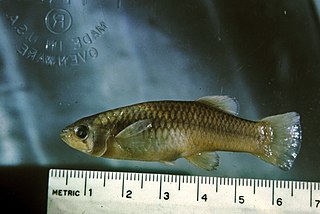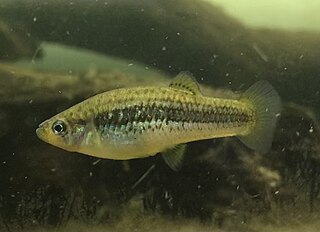
The Monterrey platyfish is a species of freshwater fish in family Poecilidae. A live-bearer, it was native to a very small section of the San Juan River system in the vicinity of the city of Monterrey, Mexico. The specific name refers to the American soldier and naturalist Darius N. Couch (1822–1897) who collected the type on a self financed expedition to Mexico.
The San Marcos gambusia is a likely extinct species of Gambusia from the family Poeciliidae that was found only in the San Marcos Springs of Central Texas. The fish has not been seen since 1983.
George Sprague Myers was an American ichthyologist who spent most of his career at Stanford University. He served as the editor of Stanford Ichthyological Bulletin as well as president of the American Society of Ichthyologists and Herpetologists. Myers was also head of the Division of Fishes at the United States National Museum, and held a position as an ichthyologist for the United States Fish and Wildlife Service. He was also an advisor in fisheries and ichthyology to the Brazilian Government.
The Lake Rukwa lampeye is a species of fish in the family Poeciliidae. Its natural habitats are intermittent rivers, freshwater marshes, and intermittent freshwater marshes. It is threatened by habitat loss. This species occurs in central Africa in Lake Rukwa, Tanzania, the Malagarasi River, Wembere River system and the upper basin of the Congo River. Its specific name honours the German physician and zoologist Friedrich Fülleborn (1866-1933), who collected the type.
The meshscaled topminnow is a species of fish in the family Poeciliidae. The two population groups are a southern group of populations found in Angola, Botswana, the Republic of the Congo, Malawi, Mozambique, and Zambia and a northern population group found in Chad, the Central African Republic, the White Nile in South Sudan and Sudan and in the northern Democratic Republic of Congo. Its natural habitat is small streams and brooks, lakes, and swamps on floodplains where it lives among aquatic vegetation. This species was described by George Albert Boulenger as Haplochilus hutereaui in 1913 with the type locality being Dungu on the upper Uelé River in the Democratic Republic of Congo. Boulenger received the type from Armand Hutereau (1875–1914), who was the head of a Belgian ethnographic expedition to the Congo, so he honoured Hutereau in the specific name.
The yellowfin gambusia is a species of fish in the family Poeciliidae. It is endemic to the Rio Conchos of Chihuahua, Mexico, where it is known as guayacon de san gregorio. This species was described in 1957 by Clark Hubbs and Victor G. Springer with the type locality given as El Ojo de San Gregorio in Chihuahua. The specific name of this fish honours the Mexican ichthyologist José Alvarez del Villar (1903-1986) for his work on the fishes of Mexico and for his assistance to Clark and Springer.

The Big Bend gambusia is a rare species of fish in the family Poeciliidae. It is endemic to the Big Bend region of the Rio Grande of the United States and Mexico. The only known remaining population is in a protected pond in the Big Bend National Park.

Gambusia hurtadoi, also known as crescent gambusia, is a species of fish in the family Poeciliidae. It is endemic to Chihuahua in Mexico, where it is known as guayacon de Hacienda Dolores. It grows to 3.5 cm (1.4 in) total length. The species was described in 1957 by Carl Leavitt Hubbs and Victor G. Springer with the type locality given as El Ojo de la Hacienda Dolores, 7 miles south of Jiminez, Chihuahua, the spring to which this species is endemic. Hubbs and Springer honoured the Mexican Leopoldo Hurtado Olin of the Departamento de Economía in Chihuahua for his assistance during their collecting expedition to Chihuahua in June 1951. Hurtado Olin also informed Hubbs and Springer of the location of El Ojo de la Hacienda Dolores.
Gambusia krumholzi, the spotfin gambusia, is a species of fish in the family Poeciliidae endemic to Mexico.
The eastcoast lampeye is a species of fish in the family Poeciliidae. It is endemic to coastal Kenya and Tanzania, where found in brackish water, mangrove swamps, pools, lagoons and river deltas. It reaches up to 5 cm (2.0 in) in total length. This fish was described by Ernst Ahl as Haplochilichthys stuhlmanni with the type locality given as Tanganyika Territory. The specific name honours the co-leader of the German East Africa Expedition (1889-1892) on which type was collected, Franz Ludwig Stuhlmann (1863-1928) of the German Colonial Service.
The yellow swordtail is a species of freshwater fish in the family Poeciliidae. It is endemic to the upper Coatzacoalcos River basin in southern Mexico. It is typically found in brooks and streams with slow current; it is less frequent in areas with strong current. The yellow swordtail is considered a threatened species by Mexican authorities. It reaches up to 5.1 cm (2.0 in) in standard length.
The northern platyfish is a small, endangered species of fish in the family Poeciliidae. It is endemic to the vicinity of Cuatro Ciénegas in the Mexican state of Coahuila. It is restricted to hot-spring heated ditches and marshes of the Laguna Santa Tecla. Its native water is shallow and vegetation-choked, with very stable temperatures that generally are around 27–30 °C (81–86 °F), although captive studies show the species also can live in slightly colder water.
The marbled swordtail is a species of freshwater fish in the family Poeciliidae. It was endemic to the Rio Salado system in Coahuila, northeastern Mexico. It was restricted to springs, connected creeks and pools in waters with a pH slightly above neutral and temperatures of 16–26 °C (61–79 °F), with captive studies indicating that the optimum temperature is around 24 °C (75 °F).
The Chiapas swordtail or upland swordtail is a species of livebearing freshwater fish of family Poeciliidae, and genus Xiphophorus. It is, therefore, in the same genus as the common platy and the swordtail. The Chiapas swordtail was discovered and first described by Donn E. Rosen in 1960, along with four other species of Xiphophorus.

The green swordtail is a species of freshwater/brackish fish in family Poeciliidae of order Cyprinodontiformes. A live-bearer, it is closely related to the southern platyfish or 'platy' (X. maculatus) and can crossbreed with it. It is native to an area of North and Central America stretching from Veracruz, Mexico, to northwestern Honduras.

Xiphophorus nezahualcoyotl, the mountain swordtail, is a live bearing fish in the family Poeciliidae. It is endemic to the northwestern Pánuco River basin in Mexico. The specific name of this fish refers to the poet, philosopher and emperor of Texcoco, Nezahualcoyotl (1402–1472).
John Roxborough Norman was an English ichthyologist.
Xiphophorus malinche, also known as highland swordtail, is a live bearing fish in the family Poeciliidae. It is endemic to the Pánuco River basin in east-central Mexico. This species is named after La Malinche, an Indian slave who played a role in the Spanish conquest as the interpreter, secretary, and mistress of Hernán Cortés.
The Dead Sea toothcarp is a species of toothcarp in the family Aphaniidae that is endemic to the Dead Sea basin. It is threatened by water fluctuation, and the introduction of cichlids and Gambusia. The specific name of this fish honours the Scottish surgeon and naturalist John Richardson (naturalist) (1787-1865) who first reported killifish in the Dead Sea basin. The Dead Sea toothcarp has been on the Red List of the International Union for Conversation of Nature since 2006.

The Nile killifish, also known as the Nile lampeye, is a species of killifish from the family Poeciliidae. It is found in the White Nile drainage in Sudan, the Nile Delta in Egypt, the Wembere and Malagarasi Rivers in Tanzania and in the Lake Victoria basin in Uganda and Tanzania. However, it is thought to have been extirpated from Egypt, the introduction of alien poecilid fish, agricultural pollution and increasing salinity are all thought to have contributed to its local extinction in the Nile Delta.






